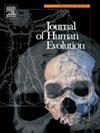A three-dimensional geometric morphometric study of Miocene ape lumbar vertebrae, with implications for hominoid locomotor evolution
IF 3.1
1区 地球科学
Q1 ANTHROPOLOGY
引用次数: 0
Abstract
Miocene apes represent snapshots in time of key transitions in hominoid evolution. While all extant apes are adapted to orthograde posture and suspensory behavior, many Miocene apes demonstrate evidence for pronogrady and habitual arboreal quadrupedalism or present ‘mosaic’ morphologies suggestive of locomotion and posture unlike any extant catarrhine. Here, we use three-dimensional geometric morphometrics to study penultimate lumbar vertebrae of extant anthropoids and those of three well-preserved Miocene apes: Ekembo nyanzae (KNM-MW 13142), Morotopithecus bishopi (UMP 67-28), and Pierolapithecus catalaunicus (IPS 21350-64), which have been interpreted as a pronograde arboreal quadruped, an orthograde suspensory or vertical climbing ape, and an orthograde vertical climber that was not adapted to suspensory behavior, respectively. Our results show that E. nyanzae shares three-dimensional shape space with terrestrial papionins, whereas M. bishopi and P. catalaunicus fall within overlapping morphospace shared by Ateles and hylobatids. Morotopithecus bishopi and P. catalaunicus share with hylobatids and brachiating atelids (Ateles and Brachyteles) well-established features such as dorsal lumbar transverse (costal) processes and a newly identified feature in this study, the presence of a convex pillar along the pars interarticularis that forms the lateral borders of the laminae. The latter feature is also shared with E. nyanzae. Together with their large body size estimates, we interpret these results to indicate that E. nyanzae was primarily a pronograde quadruped that may have been semiterrestrial rather than strictly arboreal, while M. bishopi and P. catalaunicus were adapted to both orthogrady and forelimb-dominated climbing and suspension.
中新世猿猴腰椎的三维几何形态计量学研究,对类人猿运动进化的影响
中新世猿类代表了类人猿进化关键过渡时期的快照。虽然所有现存的猿类都适应直立姿势和悬吊行为,但许多中新世猿类显示出前倾和习惯性树栖四足行走的证据,或者呈现出与任何现存的卡他林动物不同的运动和姿势的“马赛克”形态。本文利用三维几何形态测量学研究了现存类人猿和3种保存完好的中新世类人猿:Ekembo nyanzae (KNM-MW 13142)、Morotopithecus bishopi (UMP 67-28)和Pierolapithecus catalaunicus (IPS 21350-64)的第二腰椎,这3种类人猿分别被解释为前行树栖四足动物、直立悬吊或垂直攀爬猿类和不适应悬吊行为的直立攀爬猿类。我们的研究结果表明,E. nyanzae与陆生番木瓜素共享三维形态空间,而M. bishopi和P. catalaunicus则属于Ateles和hylobatids共享的重叠形态空间。Morotopithecus bishopi和P. catalaunicus与舌足和臂状舌足(Ateles和Brachyteles)有共同的特征,如腰背横突(肋突)和本研究中新发现的特征,即沿关节间部形成椎板外侧边界的凸柱的存在。后一个特征也与E. nyanzae共享。结合它们巨大的体型估计,我们解释这些结果表明,E. nyanzae主要是一种前向四足动物,可能是半陆栖的,而不是严格意义上的树栖动物,而M. bishopi和P. catalaunicus既适应直立攀登,也适应前肢主导的攀登和悬浮。
本文章由计算机程序翻译,如有差异,请以英文原文为准。
求助全文
约1分钟内获得全文
求助全文
来源期刊

Journal of Human Evolution
生物-进化生物学
CiteScore
6.30
自引率
15.60%
发文量
104
审稿时长
3 months
期刊介绍:
The Journal of Human Evolution concentrates on publishing the highest quality papers covering all aspects of human evolution. The central focus is aimed jointly at paleoanthropological work, covering human and primate fossils, and at comparative studies of living species, including both morphological and molecular evidence. These include descriptions of new discoveries, interpretative analyses of new and previously described material, and assessments of the phylogeny and paleobiology of primate species. Submissions should address issues and questions of broad interest in paleoanthropology.
 求助内容:
求助内容: 应助结果提醒方式:
应助结果提醒方式:


